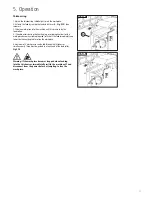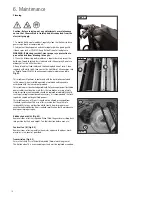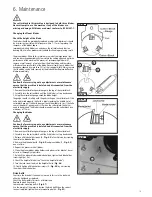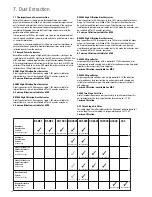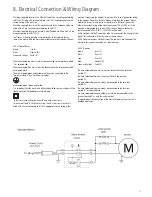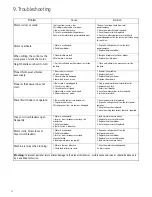
7
WARNING: FOR YOUR OWN SAFETY, DO NOT ATTEMPT TO
OPERATE YOUR PLANER THICKNESSER UNTIL IT IS COMPLETELY
ASSEMBLED AND INSTALLED ACCORDING TO
THESE INSTRUCTIONS
Safe Operation
1. The planer thicknesser should be level and stable at all times
• If using an optional wheel kit to position the machine within your
workshop, never attempt to move the machine with the surface tables in
the raised position as this will raise the centre of gravity and make the
machine unstable.
2. Familiarise yourself with the machine
• Machining operations using planer thicknessers have a history of serious
accidents. Most accidents resulted from contact with the cutter block
when surface planing due to the guard being incorrectly adjusted or
missing from the machine.
• The machine is designed for planing hard and soft woods. It is not
designed for planing any other material.
• Do not attempt to perform rebating, moulding, cutting tenons and
recessing. The machine is designed to prevent these operations from
being performed. Do not modify the machine in order to attempt any of
these operations.
3. Before switching the machine ‘ON’:
• Set and secure safety guards in position before operating the machine.
Adjust the guards to suit the size of work piece. Full details of the correct
setting of the guards is included within the manual.
• Before starting work, watch the planer while it runs. If it makes an
unfamiliar noise or vibrates excessively, switch the machine ‘OFF’
immediately and disconnect it from the power supply. Do not restart until
finding and correcting the problem.
• Regularly check that the blades and lock bars are locked tight in the
cutter block.
• Regularly check the anti-kickback fingers of the thicknesser for proper
operation.
• Make sure there are no nails, screws or foreign objects in the part of the
work piece to be planed.
• Make sure there is no debris between the work piece and the table or
fence.
• Check that the fence, guards and work holding devices are secure and
that the fixings for them are fully tightened.
• Clear the planing tables of all objects (tools, scrap pieces etc.).
• Plan the way you will hold and feed the work piece from start to finish.
4. Whilst planing:
• Never remove any of the safety guards. Keep guards operational at all
times.
• Use extra caution with large, very small or irregularly shaped
work pieces.
• Use extra supports (roller support stands etc) for any work pieces large
enough to tip when not held down to the table top.
• Do not use another person as a substitute for a table extension, or as
additional support for a work piece that is longer than the basic planer
table, or to help feed, support, or pull the work piece.
• When planing irregularly shaped work pieces, or chamfering with the
fence at 45º, plan your work support so it will not slip and be pulled
from your hands.
• When planing short work pieces an additional push block should be
used. Never attempt to plane a work piece that is too small to hold
by hand.
• Avoid awkward operations and hand positions where a sudden slip could
cause fingers or hands to move into the cutter block.
• Never make planing cuts deeper than 3mm / 1/8”.
• Plane only one work piece at a time.
• Keep your face and body to one side, out of line with a possible
kick back.
• If the work piece binds when thicknessing the machine may stall. If
this happens, switch the machine ‘OFF’ immediately and follow the
instructions detailed in the manual for safely removing the work piece.
Do not attempt to free the work piece whilst the machine is running.
5. Maintenance:
• Regularly check that all safety guards are present and in full
working order.
• Regularly check that the bridge guard moves freely, both horizontally
and vertically.
• Keep the guards clean and free from waste material and deposits
of resin.
• Regularly clean the planer table and thicknesser bed and apply a suitable
lubricant (silicone wax or spray to help the work piece slide easily.
• The planer knives should be sharpened regularly to reduce the risk of
snatching and kick back.
• Do not exceed maximum allowable blade projection over cutter block of
1.0mm/ 0.040 inch +10%.
6. This machine falls under the scope of the ‘Health & Safety at Work etc.
Act 1974’, and the ‘Provision & Use of Work Equipment Regulations 1998’.
In addition the elimination or control of risks from wood dust is included in
the above regulations and the ‘Control of Substances Hazardous to Health
(COSHH) Regulations 2002’. We recommend that you study and follow
these regulations.
Further guidance is available from The Health & Safety Executive and their
website www.hse.gov.uk.
Additional Health & Safety for Planer Thicknessers
Summary of Contents for PT107
Page 29: ...29 10 Parts List Diagrams cont ...
Page 33: ...33 ...

















